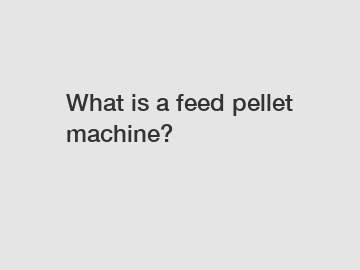What is a feed pellet machine?
In the world of animal husbandry, ensuring proper nutrition for livestock is of utmost importance for their health and overall productivity. With advances in technology, the feed pellet machine has emerged as an incredible tool that transforms animal feed production. This blog aims to delve into the intricate details of what a feed pellet machine is, its working principles, and the numerous benefits it offers to farmers and livestock.
Section 1: Understanding the Feed Pellet Machine.
The feed pellet machine, also known as a pellet mill, is a specialized device designed to convert various raw materials into compressed feed pellets. It promotes a standardized and convenient feeding method that maximizes the nutritional value of animal feed. These machines are capable of processing a wide range of materials, including grains, agro-waste, and even meat and bone meal, ensuring a balanced diet for livestock.

Section 2: Working Principles.
Feed pellet machines work on the principle of compression, using pressure to shape raw materials into dense, compact pellets. Firstly, the raw material is finely ground, which enhances its palatability and aids digestion. The uniform particle size also enables consistent pellet formation. The ground material is then mixed with necessary additives such as vitamins, minerals, and binding agents to enhance nutritional value and pellet integrity. Finally, the mixture is compressed through die holes, and the extruded pellets are subsequently cut into desired lengths by a cutter.
Section 3: Benefits of a Feed Pellet Machine.
A. Enhanced Nutritional Value: Unlike traditional feeding methods, feed pellets created by these machines retain optimal levels of proteins, carbohydrates, and other vital nutrients. The compressed form reduces feed wastage and improves nutrient absorption, leading to healthier and more productive animals.
B. Improved Digestibility: The pelletizing process involves heat, which partially denatures anti-nutritional factors and destroys pathogens. This enhances the digestibility of the feed, minimizing digestive disorders and improving overall animal health.
C. Ease of Handling and Storage: Feed pellets are compact and easy to handle, reducing labor and storage requirements significantly. They are less prone to spoilage and contamination, ensuring a consistent supply of fresh and hygienic feed for livestock.
D. Cost-Effectiveness: Feed pellet machines allow farmers to utilize a wide range of raw materials. By incorporating locally available ingredients, farmers can save substantial costs by reducing reliance on expensive commercial feed. Furthermore, the ability to control the pellet size and composition enables the optimization of feed formulation, leading to reduced wastage and increased cost-efficiency.
E. Environmental Sustainability: Innovative feed pellet machines can efficiently process agricultural waste products, such as corn stalks, rice straw, or sawdust, into valuable feed. By utilizing these by-products, farmers can reduce waste generation while creating a sustainable and eco-friendly feeding solution.
Section 4: The Future of Feed Pellet Machines.
As technology further advances, feed pellet machines continue to undergo improvements. Innovations in automation, sensor technologies, and data analytics are being integrated into pellet mills to ensure precision, efficiency, and cost-effectiveness. Advanced machines now have intelligent systems that can monitor and regulate factors such as pellet density, moisture content, and temperature, guaranteeing consistent pellet quality.
Additionally, the feed pellet industry has seen a rise in the development of specialized machines catering to specific livestock, such as poultry, swine, or aquaculture feeds. This specialization allows for the customization of nutritional requirements, fostering optimal growth and minimizing health risks.
Conclusion:
The feed pellet machine has revolutionized animal feed production by providing a standardized, efficient, and cost-effective feeding solution for farmers. Its ability to convert various raw materials into nutritionally balanced pellets enhances animal health and productivity. With continuous advancements in technology, feed pellet machines are set to play a vital role in meeting the growing global demand for high-quality livestock nutrition while contributing to sustainable agriculture practices.
If you are looking for more details, kindly visit animal feed conditioner manufacturer, animal feed coating machine, pelleting aids for animal feed.



Comments
0